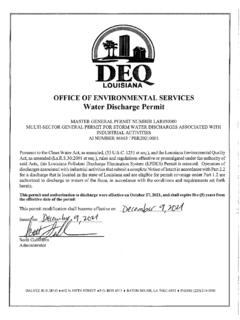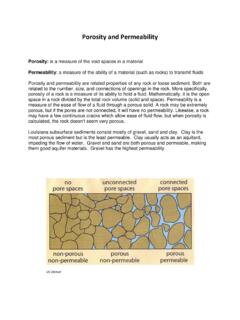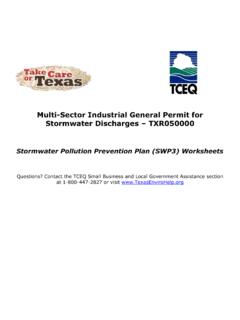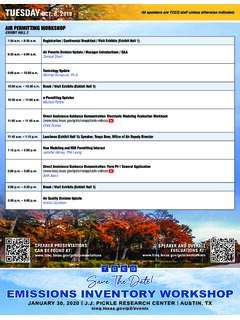Transcription of ADDENDUM A GUIDANCE PROCEDURES RELATING TO …
1 ADDENDUM A GUIDANCE PROCEDURES RELATING TO ENDANGERED SPECIES PROTECTION 1 ENDANGERED SPECIES GUIDANCE - msgp A list of endangered and threatened species that EPA has determined, and LDEQ concurs, may be affected by the activities covered by the multi - sector general permit ( msgp ) is available under (See also II below.) These species are listed by parish. In order to get msgp coverage, applicants must: Indicate in the box provided on the Notice of Intent (NOI) whether any species listed in this GUIDANCE or critical habitat are in proximity to the facility, and Certify pursuant to Part of the permit that they have followed the PROCEDURES found in this GUIDANCE to protect listed endangered and threatened species and designated critical habitat and that the storm water discharges and BMPs to control storm water run off covered under this permit meet the eligibility requirements of Part of this permit .
2 Signature and submittal of the NOI is deemed to constitute the applicant's certification of eligibility for permit coverage. To do this, please follow steps 1 through 6 below when completing the NOI and developing the pollution prevention plan. NOTE: At any step in the determination, applicants may contact the Fish and Wildlife Service (FWS) for GUIDANCE . That request should be in writing and should include a description of the facility and a topographic map depicting the location of the facility and the associated storm water discharges. U. S. Fish and Wildlife Service 646 Cajundome Blvd. Suite 400 Lafayette, LA 70506 (337) 291-3108 I. Assessing the Effects of Your Discharge and Discharge-Related Activities You must follow the PROCEDURES in this ADDENDUM to assess the potential effects of applicable storm water discharges, discharge-related activities, and allowable non-storm water discharges on listed species and their critical habitat and determine which of the eligibility criterion (see Part II), if any, you qualify under.
3 When evaluating the potential effects of your activities, you must consider effects to listed species or critical habitats within the action area. Action area is defined in Part 7 of the permit as all areas affected directly or indirectly by the storm water discharges, allowable non-storm water discharges, and storm water discharge-related activities, and not merely the immediate area involved in these discharges 2 and activities. This includes areas beyond the footprint of the facility that are likely to be affected by storm water discharges, discharge-related activities, and allowable non-storm water discharges. For example, normal construction, operations and maintenance activities can result in noise impacts and discharges of pollutants into downstream areas which can increase the action area beyond the footprint of the facility.
4 Facility is also defined in Part 7 of the permit . STEP 1: DETERMINE IF THE ELIGIBILITY REQUIREMENTS OF CRITERION B OR E CAN BE MET. You should first determine whether you are eligible under Criterion B or E because of a previously completed ESA Section 7 consultation, a previously issued ESA Section 10 permit , or because your activities were already addressed in another discharger s certification of eligibility as follows: i. The effects of your activities have been addressed through approval of a Habitat Conservation Plan under Section 10 of the ESA (check box corresponding to Criterion B). Storm water discharges from your industrial facility may be authorized by this msgp if some activity is authorized through the issuance of a permit under Section 10 of the ESA and that authorization addressed the effects of your storm water discharges on federally-listed species and designated critical habitat.
5 You must follow Fish and Wildlife Service (FWS) and/or National Marine Fisheries Service, also known as NOAA Fisheries (NMFS) PROCEDURES when applying for an ESA Section 10 permit (see 50 CFR (b)(1) for FWS and for NMFS). Application instructions for Section 10 permits for FWS and NMFS can be obtained by accessing the FWS websites ( and ) or by contacting the appropriate FWS and NMFS regional office. ii. You are covered under the eligibility certification of another operator for the project area (check box corresponding to Criterion E). Your storm water discharges, discharge-related activities, and allowable non-storm water discharges were already addressed in another discharger s certification of eligibility under Criteria A, B, C, or D, which also included your facility and determined that federally listed endangered or threatened species or designated critical habitat would not be jeopardized.
6 To certify eligibility under this criterion there must be no lapse of coverage in the other operator s certification. By certifying eligibility under Criterion E, you agree to comply with any measures or controls upon which the other discharge certification under Criterion B, C, or D was based. If your certification is based on another operator s certification under Criterion E, that certification is valid only if you have determination showing that the other operator has certified under Criterion E, and you provide LDEQ with the relevant supporting information in your NOI form. Certification under Criterion E is discussed in more detail in the Fact Sheet that accompanies this permit . 3 STEP 2: DETERMINE IF LISTED THREATENED OR ENDANGERED SPECIES AND CRITICAL HABITAT ARE PRESENT IN THE ACTION AREA.
7 Next, you should first determine whether federally-listed species are likely to occur in your action area. If you determine that there is a federally-listed species likely to occur in your action area, follow Step 3. If you determine that there are no federally-listed species likely to occur in your action area, you can certify that the facility meets Criteria A (check box corresponding to Criteria A). You can do this by obtaining a list of threatened and endangered species that are likely to occur in your general area, including the appropriate receiving water for your discharges. County-specific or sometimes township-specific lists of Federally threatened and endangered species are available from the local offices of FWS, and NMFS, or on their internet sites.
8 The types of species that are likely to be present determine which Service office you should contact (in general , NMFS has jurisdiction over marine, estuarine, and anadromous species). If there are listed species in your parish or city or town, you must then determine, as best you are able, whether any of the species are likely to occur in your action area (use the Services as necessary). general species information can be found at You must also check to see if critical habitat has been designated and whether such areas overlap in your action area. Critical habitat should be listed on the species list for your parish or town or city available from the appropriate Service office. You can also find critical habitat designations at 50 CFR Parts 17 and 226 and at If there are no listed species and no critical habitat areas that overlap your action area, or if your local FWS or NMFS indicates that listed species are not likely to occur in your action area, you have satisfied your eligibility obligations under Criterion A (check box corresponding to Criterion A).
9 If there are listed species and if you determine or your local FWS or NMFS indicates that these species could occur in the action area, you will need to evaluate whether your action area supports habitat(s) that are suitable for listed species or the constituent elements of critical habitat. Your evaluation may utilize one or more of the following approaches: Gather information about the species and critical habitat that are likely to occur in your action area ( ). Conduct a visual inspection of the action area to assess the potential presence of listed species and their habitats. Compare the size and types of habitats available in your action area and adjacent areas with the size and types of habitats used by listed species and constituent elements of critical habitat.
10 This method may be particularly suitable for facilities where the action area is smaller in size or located in non-natural settings such as highly urbanized areas or industrial parks where there is little or nor natural habitat, or for facilities that discharge directly into municipal separate storm sewer systems (MS4s). Conduct a formal biological survey (typically performed by environmental consulting 4 firms). In some cases, biological surveys may be an appropriate way to assess whether species are likely to be located in the action area and whether there could be adverse effects to such species. A biological survey may in some cases be useful in conjunction with Steps Two, Three or Four of these instructions.




